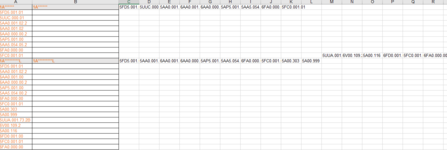Hi Guys,
I need help please.
I have a long list of values for that I need to transpose, however I need a formula that can dynamically select the number of lines to transpose.
Mine it's a list of part numbers, with the Parent part numbers starting by 1 and Childs part numbers randomly starting by any other number (4-5-6 etc.)
In the list for each Parent there is a variable number of Childs parts.
The Formula should look at the Parent and transposing all the Childs in the same row of the Parent.
I'm ok as excel user but I'm not up to this level, any help is welcome and a bit of code will do as well , however a solution by a formula is preferred.
Thanks in advance
I need help please.
I have a long list of values for that I need to transpose, however I need a formula that can dynamically select the number of lines to transpose.
Mine it's a list of part numbers, with the Parent part numbers starting by 1 and Childs part numbers randomly starting by any other number (4-5-6 etc.)
In the list for each Parent there is a variable number of Childs parts.
The Formula should look at the Parent and transposing all the Childs in the same row of the Parent.
I'm ok as excel user but I'm not up to this level, any help is welcome and a bit of code will do as well , however a solution by a formula is preferred.
Thanks in advance
| 1Blueparent | after the Formula --> | 1Blueparent | 4child1 | 6child2 | |
| 4child1 | |||||
| 6child2 | |||||
| 1Redparent | 1Redparent | 5child1 | etc. | ||
| 5child1 |






